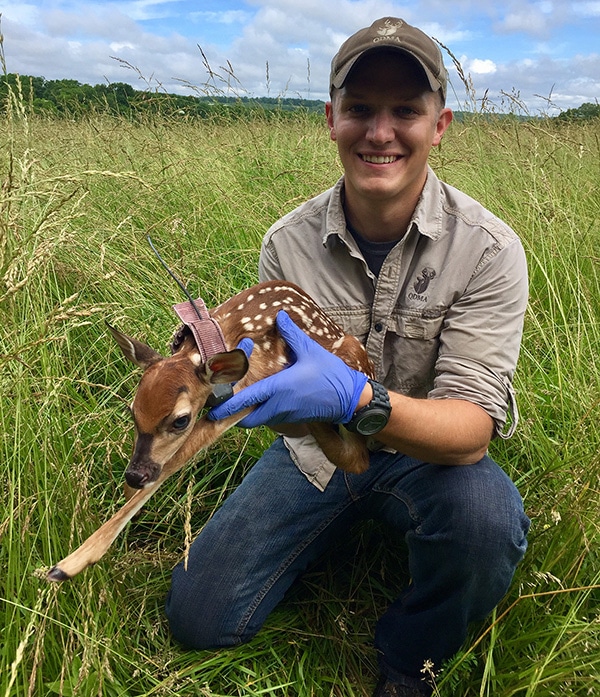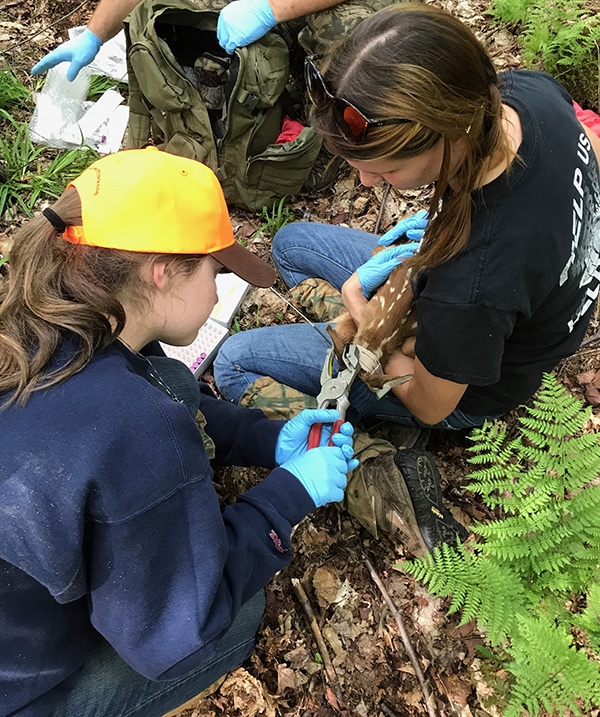
Alex Foster, a Wildlife Management Cooperative Specialist with QDMA, assisting with a fawn survival study in Missouri.
What came first – the doe or the fawn? Following the “chicken or the egg” analogy, you need a doe to produce a fawn, and you need a fawn to produce a doe. In reality, who came first is irrelevant as long as deer hunters and managers fully realize the importance of both. In the past, abundant deer densities and high fawn recruitment rates made the question less important as many areas in the whitetail’s range had a seemingly endless supply of deer. The situation is very different in many areas today. For example, the total antlerless deer harvest in the U.S. has dropped nearly 20 percent in the past decade. Fawn recruitment rates have dropped nearly 25 percent in the past 15 years, and fawn breeding rates have dropped over 50 percent since 2009. This all equates to an increasing importance on each fawn born this spring.
QDMA closely monitors fawn survival rates and research projects on this subject. In fact, QDMA staff member Alex Foster assisted with such a project in Missouri earlier this month, and QDMA intern Jackie Rosenberger is currently working on such a study with the Pennsylvania Game Commission.

QDMA intern Jackie Rosenberger (left) is working on a fawn survival study in Pennsylvania.
…fawns with the least amount of “edge” in their home ranges were more than 2 times as likely to be eaten by a coyote than fawns with greater edge availability.
There have been numerous studies during the past decade looking at fawn survival and predation rates. A recently published one by Dr. Will Gulsby and his colleagues reanalyzed data from a prior study and highlighted the importance of good cover to fawn survival. The paper was titled Landscape heterogeneity reduces coyote predation on white-tailed deer fawns, and it showed fawns with the least amount of “edge” in their home ranges were more than 2 times as likely to be eaten by a coyote than fawns with greater edge availability.
Many factors impact fawn survival, and predation tops that list. Bears, coyotes, bobcats and others eat fawns, and as managers we need to accept some level of loss from each. In areas where losses are excessive, intensive annual predator control may help. However, this is an unrealistic expectation for most deer managers. Enhanced cover, however, is well within the realm of possibility for most hunters. Good fawning cover has the added benefit of also being extremely beneficial to adult deer and numerous other wildlife species.
Guard against excessive predation and other fawn losses today by ensuring fawns in your area have adequate cover. The two videos below provide information on how to do this in your area. Here’s to good cover, abundant fawns, and great hunting this fall.
How Can I Improve My Fawning Cover? AskQDMAIn this #AskQDMA video, Brian Grossman answers a question from Joey Belmont of Alabama about how to improve the fawning cover on his 100-acre property.
Posted by The Quality Deer Management Association on Thursday, September 15, 2016